HLSC122: Critical Appraisal of Caregiver Experience in Stroke Rehab
VerifiedAdded on 2023/06/11
|6
|1832
|157
Essay
AI Summary
This essay critically appraises a research article concerning caregiver experiences in stroke rehabilitation. The appraisal evaluates the study's quality, focusing on the authors' expertise, the study's purpose and design, methodology, and results. It assesses the rigour and validity of the research, examining aspects like the appropriateness of the mixed-methods design (qualitative and quantitative approaches), sampling methods, data collection through interviews, and statistical analysis using ANOVA. The essay also discusses the presentation of results, strategies to improve the study's rigour, and the alignment of findings with the study's aims. The conclusion reflects on the study's limitations, such as the generalization of data and potential for bias, while emphasizing the importance of critical appraisal in validating research evidence and informing further research amendments.

Evidence 122
1
1
Paraphrase This Document
Need a fresh take? Get an instant paraphrase of this document with our AI Paraphraser
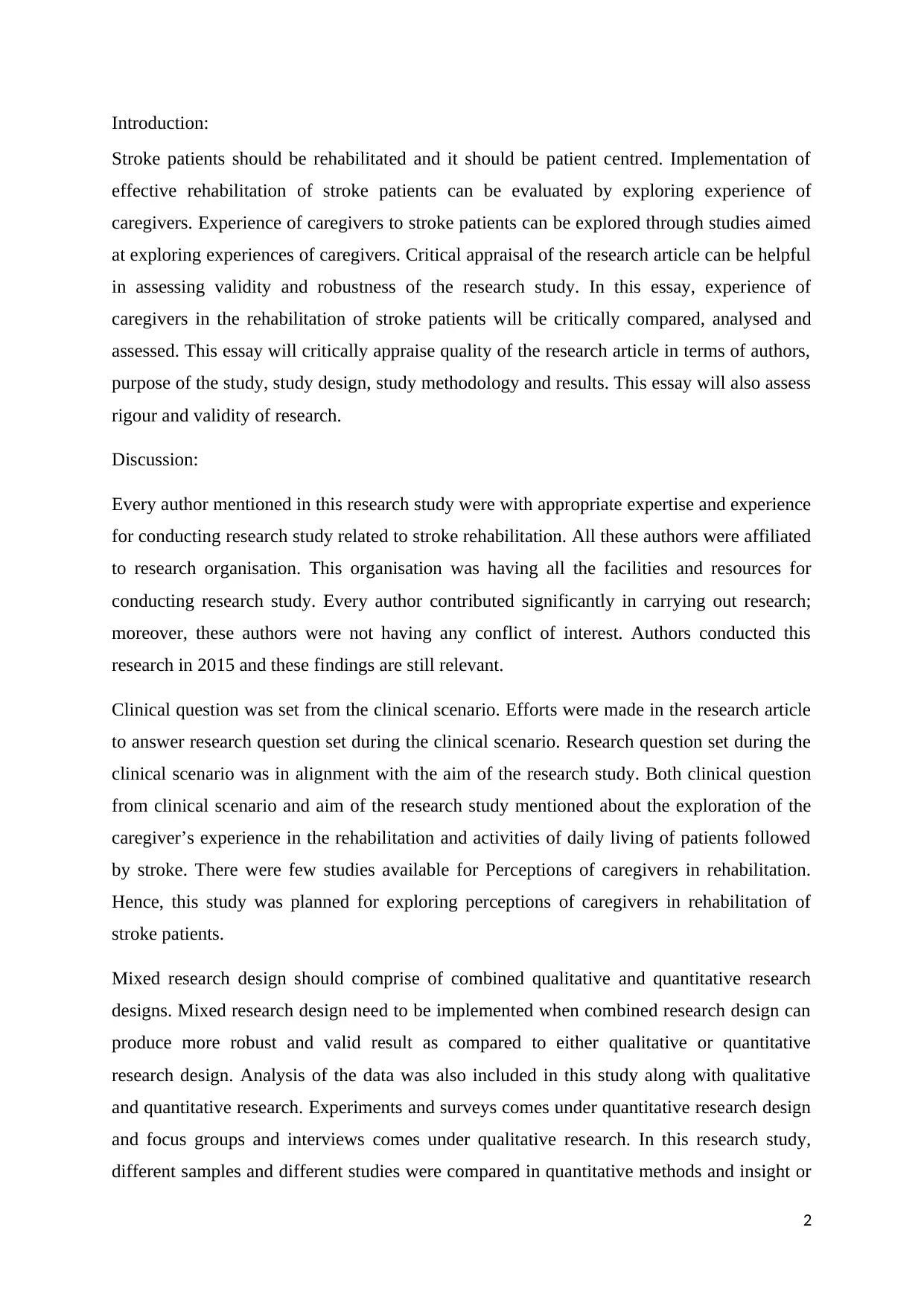
Introduction:
Stroke patients should be rehabilitated and it should be patient centred. Implementation of
effective rehabilitation of stroke patients can be evaluated by exploring experience of
caregivers. Experience of caregivers to stroke patients can be explored through studies aimed
at exploring experiences of caregivers. Critical appraisal of the research article can be helpful
in assessing validity and robustness of the research study. In this essay, experience of
caregivers in the rehabilitation of stroke patients will be critically compared, analysed and
assessed. This essay will critically appraise quality of the research article in terms of authors,
purpose of the study, study design, study methodology and results. This essay will also assess
rigour and validity of research.
Discussion:
Every author mentioned in this research study were with appropriate expertise and experience
for conducting research study related to stroke rehabilitation. All these authors were affiliated
to research organisation. This organisation was having all the facilities and resources for
conducting research study. Every author contributed significantly in carrying out research;
moreover, these authors were not having any conflict of interest. Authors conducted this
research in 2015 and these findings are still relevant.
Clinical question was set from the clinical scenario. Efforts were made in the research article
to answer research question set during the clinical scenario. Research question set during the
clinical scenario was in alignment with the aim of the research study. Both clinical question
from clinical scenario and aim of the research study mentioned about the exploration of the
caregiver’s experience in the rehabilitation and activities of daily living of patients followed
by stroke. There were few studies available for Perceptions of caregivers in rehabilitation.
Hence, this study was planned for exploring perceptions of caregivers in rehabilitation of
stroke patients.
Mixed research design should comprise of combined qualitative and quantitative research
designs. Mixed research design need to be implemented when combined research design can
produce more robust and valid result as compared to either qualitative or quantitative
research design. Analysis of the data was also included in this study along with qualitative
and quantitative research. Experiments and surveys comes under quantitative research design
and focus groups and interviews comes under qualitative research. In this research study,
different samples and different studies were compared in quantitative methods and insight or
2
Stroke patients should be rehabilitated and it should be patient centred. Implementation of
effective rehabilitation of stroke patients can be evaluated by exploring experience of
caregivers. Experience of caregivers to stroke patients can be explored through studies aimed
at exploring experiences of caregivers. Critical appraisal of the research article can be helpful
in assessing validity and robustness of the research study. In this essay, experience of
caregivers in the rehabilitation of stroke patients will be critically compared, analysed and
assessed. This essay will critically appraise quality of the research article in terms of authors,
purpose of the study, study design, study methodology and results. This essay will also assess
rigour and validity of research.
Discussion:
Every author mentioned in this research study were with appropriate expertise and experience
for conducting research study related to stroke rehabilitation. All these authors were affiliated
to research organisation. This organisation was having all the facilities and resources for
conducting research study. Every author contributed significantly in carrying out research;
moreover, these authors were not having any conflict of interest. Authors conducted this
research in 2015 and these findings are still relevant.
Clinical question was set from the clinical scenario. Efforts were made in the research article
to answer research question set during the clinical scenario. Research question set during the
clinical scenario was in alignment with the aim of the research study. Both clinical question
from clinical scenario and aim of the research study mentioned about the exploration of the
caregiver’s experience in the rehabilitation and activities of daily living of patients followed
by stroke. There were few studies available for Perceptions of caregivers in rehabilitation.
Hence, this study was planned for exploring perceptions of caregivers in rehabilitation of
stroke patients.
Mixed research design should comprise of combined qualitative and quantitative research
designs. Mixed research design need to be implemented when combined research design can
produce more robust and valid result as compared to either qualitative or quantitative
research design. Analysis of the data was also included in this study along with qualitative
and quantitative research. Experiments and surveys comes under quantitative research design
and focus groups and interviews comes under qualitative research. In this research study,
different samples and different studies were compared in quantitative methods and insight or
2
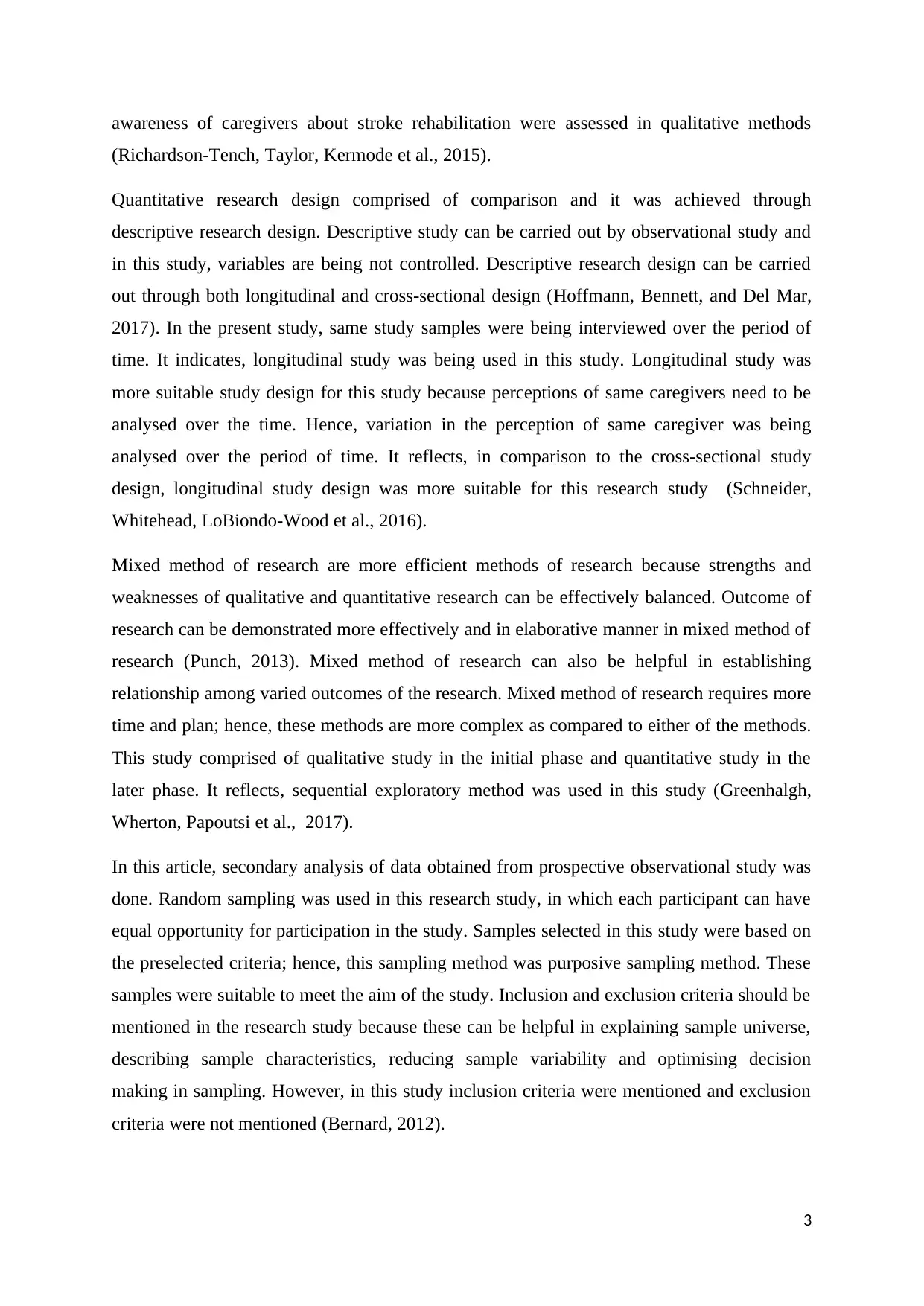
awareness of caregivers about stroke rehabilitation were assessed in qualitative methods
(Richardson-Tench, Taylor, Kermode et al., 2015).
Quantitative research design comprised of comparison and it was achieved through
descriptive research design. Descriptive study can be carried out by observational study and
in this study, variables are being not controlled. Descriptive research design can be carried
out through both longitudinal and cross-sectional design (Hoffmann, Bennett, and Del Mar,
2017). In the present study, same study samples were being interviewed over the period of
time. It indicates, longitudinal study was being used in this study. Longitudinal study was
more suitable study design for this study because perceptions of same caregivers need to be
analysed over the time. Hence, variation in the perception of same caregiver was being
analysed over the period of time. It reflects, in comparison to the cross-sectional study
design, longitudinal study design was more suitable for this research study (Schneider,
Whitehead, LoBiondo-Wood et al., 2016).
Mixed method of research are more efficient methods of research because strengths and
weaknesses of qualitative and quantitative research can be effectively balanced. Outcome of
research can be demonstrated more effectively and in elaborative manner in mixed method of
research (Punch, 2013). Mixed method of research can also be helpful in establishing
relationship among varied outcomes of the research. Mixed method of research requires more
time and plan; hence, these methods are more complex as compared to either of the methods.
This study comprised of qualitative study in the initial phase and quantitative study in the
later phase. It reflects, sequential exploratory method was used in this study (Greenhalgh,
Wherton, Papoutsi et al., 2017).
In this article, secondary analysis of data obtained from prospective observational study was
done. Random sampling was used in this research study, in which each participant can have
equal opportunity for participation in the study. Samples selected in this study were based on
the preselected criteria; hence, this sampling method was purposive sampling method. These
samples were suitable to meet the aim of the study. Inclusion and exclusion criteria should be
mentioned in the research study because these can be helpful in explaining sample universe,
describing sample characteristics, reducing sample variability and optimising decision
making in sampling. However, in this study inclusion criteria were mentioned and exclusion
criteria were not mentioned (Bernard, 2012).
3
(Richardson-Tench, Taylor, Kermode et al., 2015).
Quantitative research design comprised of comparison and it was achieved through
descriptive research design. Descriptive study can be carried out by observational study and
in this study, variables are being not controlled. Descriptive research design can be carried
out through both longitudinal and cross-sectional design (Hoffmann, Bennett, and Del Mar,
2017). In the present study, same study samples were being interviewed over the period of
time. It indicates, longitudinal study was being used in this study. Longitudinal study was
more suitable study design for this study because perceptions of same caregivers need to be
analysed over the time. Hence, variation in the perception of same caregiver was being
analysed over the period of time. It reflects, in comparison to the cross-sectional study
design, longitudinal study design was more suitable for this research study (Schneider,
Whitehead, LoBiondo-Wood et al., 2016).
Mixed method of research are more efficient methods of research because strengths and
weaknesses of qualitative and quantitative research can be effectively balanced. Outcome of
research can be demonstrated more effectively and in elaborative manner in mixed method of
research (Punch, 2013). Mixed method of research can also be helpful in establishing
relationship among varied outcomes of the research. Mixed method of research requires more
time and plan; hence, these methods are more complex as compared to either of the methods.
This study comprised of qualitative study in the initial phase and quantitative study in the
later phase. It reflects, sequential exploratory method was used in this study (Greenhalgh,
Wherton, Papoutsi et al., 2017).
In this article, secondary analysis of data obtained from prospective observational study was
done. Random sampling was used in this research study, in which each participant can have
equal opportunity for participation in the study. Samples selected in this study were based on
the preselected criteria; hence, this sampling method was purposive sampling method. These
samples were suitable to meet the aim of the study. Inclusion and exclusion criteria should be
mentioned in the research study because these can be helpful in explaining sample universe,
describing sample characteristics, reducing sample variability and optimising decision
making in sampling. However, in this study inclusion criteria were mentioned and exclusion
criteria were not mentioned (Bernard, 2012).
3
⊘ This is a preview!⊘
Do you want full access?
Subscribe today to unlock all pages.

Trusted by 1+ million students worldwide
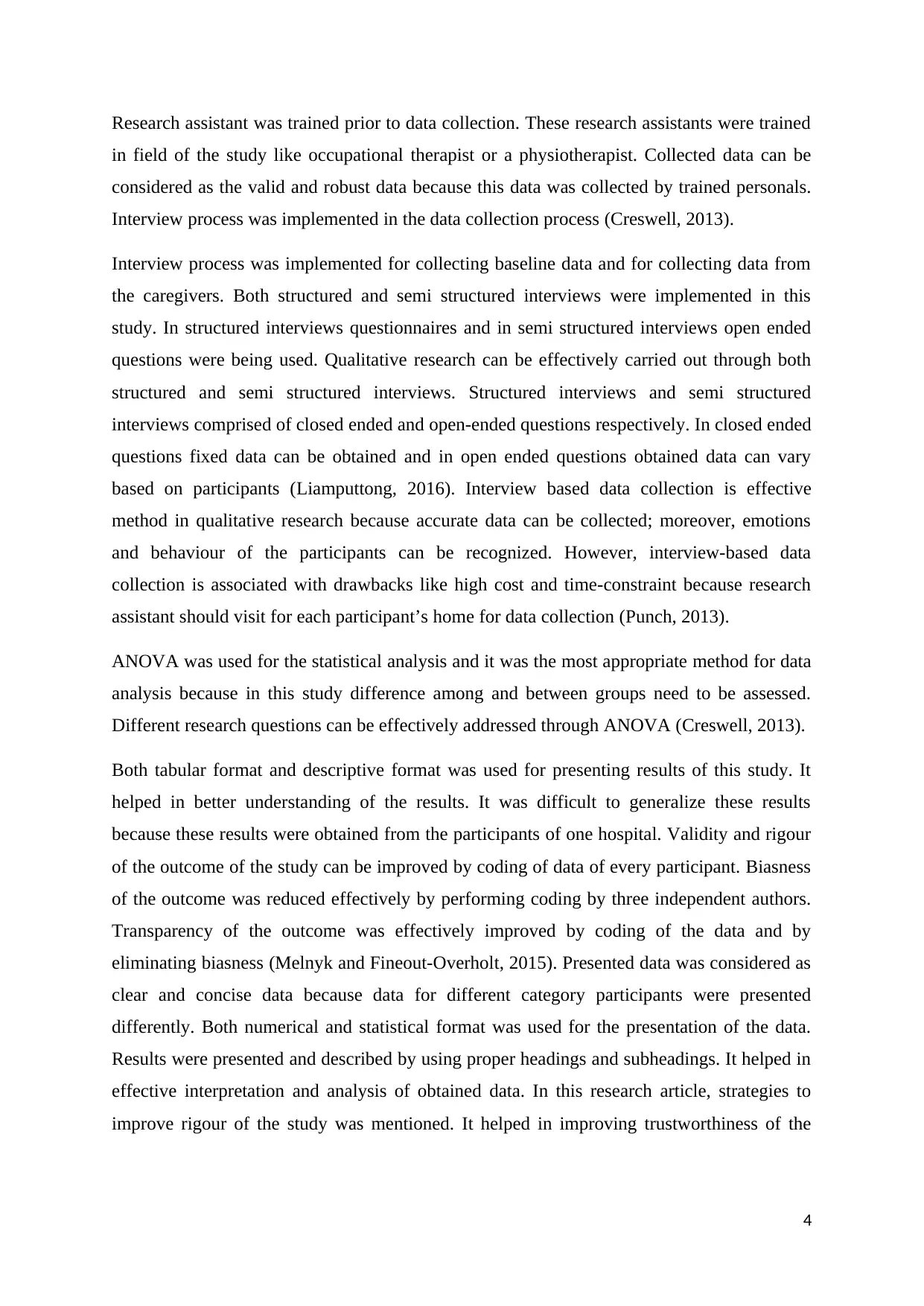
Research assistant was trained prior to data collection. These research assistants were trained
in field of the study like occupational therapist or a physiotherapist. Collected data can be
considered as the valid and robust data because this data was collected by trained personals.
Interview process was implemented in the data collection process (Creswell, 2013).
Interview process was implemented for collecting baseline data and for collecting data from
the caregivers. Both structured and semi structured interviews were implemented in this
study. In structured interviews questionnaires and in semi structured interviews open ended
questions were being used. Qualitative research can be effectively carried out through both
structured and semi structured interviews. Structured interviews and semi structured
interviews comprised of closed ended and open-ended questions respectively. In closed ended
questions fixed data can be obtained and in open ended questions obtained data can vary
based on participants (Liamputtong, 2016). Interview based data collection is effective
method in qualitative research because accurate data can be collected; moreover, emotions
and behaviour of the participants can be recognized. However, interview-based data
collection is associated with drawbacks like high cost and time-constraint because research
assistant should visit for each participant’s home for data collection (Punch, 2013).
ANOVA was used for the statistical analysis and it was the most appropriate method for data
analysis because in this study difference among and between groups need to be assessed.
Different research questions can be effectively addressed through ANOVA (Creswell, 2013).
Both tabular format and descriptive format was used for presenting results of this study. It
helped in better understanding of the results. It was difficult to generalize these results
because these results were obtained from the participants of one hospital. Validity and rigour
of the outcome of the study can be improved by coding of data of every participant. Biasness
of the outcome was reduced effectively by performing coding by three independent authors.
Transparency of the outcome was effectively improved by coding of the data and by
eliminating biasness (Melnyk and Fineout-Overholt, 2015). Presented data was considered as
clear and concise data because data for different category participants were presented
differently. Both numerical and statistical format was used for the presentation of the data.
Results were presented and described by using proper headings and subheadings. It helped in
effective interpretation and analysis of obtained data. In this research article, strategies to
improve rigour of the study was mentioned. It helped in improving trustworthiness of the
4
in field of the study like occupational therapist or a physiotherapist. Collected data can be
considered as the valid and robust data because this data was collected by trained personals.
Interview process was implemented in the data collection process (Creswell, 2013).
Interview process was implemented for collecting baseline data and for collecting data from
the caregivers. Both structured and semi structured interviews were implemented in this
study. In structured interviews questionnaires and in semi structured interviews open ended
questions were being used. Qualitative research can be effectively carried out through both
structured and semi structured interviews. Structured interviews and semi structured
interviews comprised of closed ended and open-ended questions respectively. In closed ended
questions fixed data can be obtained and in open ended questions obtained data can vary
based on participants (Liamputtong, 2016). Interview based data collection is effective
method in qualitative research because accurate data can be collected; moreover, emotions
and behaviour of the participants can be recognized. However, interview-based data
collection is associated with drawbacks like high cost and time-constraint because research
assistant should visit for each participant’s home for data collection (Punch, 2013).
ANOVA was used for the statistical analysis and it was the most appropriate method for data
analysis because in this study difference among and between groups need to be assessed.
Different research questions can be effectively addressed through ANOVA (Creswell, 2013).
Both tabular format and descriptive format was used for presenting results of this study. It
helped in better understanding of the results. It was difficult to generalize these results
because these results were obtained from the participants of one hospital. Validity and rigour
of the outcome of the study can be improved by coding of data of every participant. Biasness
of the outcome was reduced effectively by performing coding by three independent authors.
Transparency of the outcome was effectively improved by coding of the data and by
eliminating biasness (Melnyk and Fineout-Overholt, 2015). Presented data was considered as
clear and concise data because data for different category participants were presented
differently. Both numerical and statistical format was used for the presentation of the data.
Results were presented and described by using proper headings and subheadings. It helped in
effective interpretation and analysis of obtained data. In this research article, strategies to
improve rigour of the study was mentioned. It helped in improving trustworthiness of the
4
Paraphrase This Document
Need a fresh take? Get an instant paraphrase of this document with our AI Paraphraser
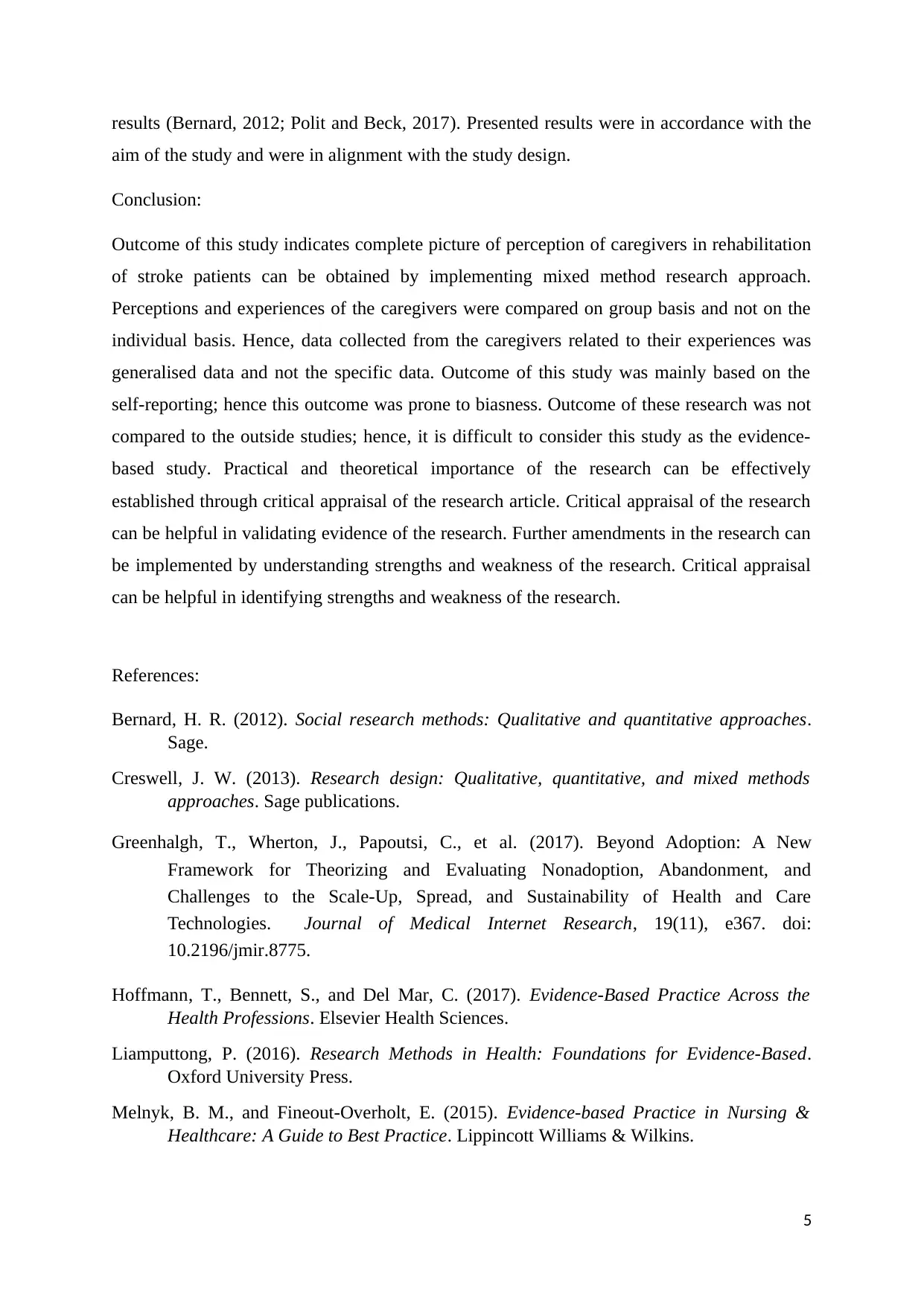
results (Bernard, 2012; Polit and Beck, 2017). Presented results were in accordance with the
aim of the study and were in alignment with the study design.
Conclusion:
Outcome of this study indicates complete picture of perception of caregivers in rehabilitation
of stroke patients can be obtained by implementing mixed method research approach.
Perceptions and experiences of the caregivers were compared on group basis and not on the
individual basis. Hence, data collected from the caregivers related to their experiences was
generalised data and not the specific data. Outcome of this study was mainly based on the
self-reporting; hence this outcome was prone to biasness. Outcome of these research was not
compared to the outside studies; hence, it is difficult to consider this study as the evidence-
based study. Practical and theoretical importance of the research can be effectively
established through critical appraisal of the research article. Critical appraisal of the research
can be helpful in validating evidence of the research. Further amendments in the research can
be implemented by understanding strengths and weakness of the research. Critical appraisal
can be helpful in identifying strengths and weakness of the research.
References:
Bernard, H. R. (2012). Social research methods: Qualitative and quantitative approaches.
Sage.
Creswell, J. W. (2013). Research design: Qualitative, quantitative, and mixed methods
approaches. Sage publications.
Greenhalgh, T., Wherton, J., Papoutsi, C., et al. (2017). Beyond Adoption: A New
Framework for Theorizing and Evaluating Nonadoption, Abandonment, and
Challenges to the Scale-Up, Spread, and Sustainability of Health and Care
Technologies. Journal of Medical Internet Research, 19(11), e367. doi:
10.2196/jmir.8775.
Hoffmann, T., Bennett, S., and Del Mar, C. (2017). Evidence-Based Practice Across the
Health Professions. Elsevier Health Sciences.
Liamputtong, P. (2016). Research Methods in Health: Foundations for Evidence-Based.
Oxford University Press.
Melnyk, B. M., and Fineout-Overholt, E. (2015). Evidence-based Practice in Nursing &
Healthcare: A Guide to Best Practice. Lippincott Williams & Wilkins.
5
aim of the study and were in alignment with the study design.
Conclusion:
Outcome of this study indicates complete picture of perception of caregivers in rehabilitation
of stroke patients can be obtained by implementing mixed method research approach.
Perceptions and experiences of the caregivers were compared on group basis and not on the
individual basis. Hence, data collected from the caregivers related to their experiences was
generalised data and not the specific data. Outcome of this study was mainly based on the
self-reporting; hence this outcome was prone to biasness. Outcome of these research was not
compared to the outside studies; hence, it is difficult to consider this study as the evidence-
based study. Practical and theoretical importance of the research can be effectively
established through critical appraisal of the research article. Critical appraisal of the research
can be helpful in validating evidence of the research. Further amendments in the research can
be implemented by understanding strengths and weakness of the research. Critical appraisal
can be helpful in identifying strengths and weakness of the research.
References:
Bernard, H. R. (2012). Social research methods: Qualitative and quantitative approaches.
Sage.
Creswell, J. W. (2013). Research design: Qualitative, quantitative, and mixed methods
approaches. Sage publications.
Greenhalgh, T., Wherton, J., Papoutsi, C., et al. (2017). Beyond Adoption: A New
Framework for Theorizing and Evaluating Nonadoption, Abandonment, and
Challenges to the Scale-Up, Spread, and Sustainability of Health and Care
Technologies. Journal of Medical Internet Research, 19(11), e367. doi:
10.2196/jmir.8775.
Hoffmann, T., Bennett, S., and Del Mar, C. (2017). Evidence-Based Practice Across the
Health Professions. Elsevier Health Sciences.
Liamputtong, P. (2016). Research Methods in Health: Foundations for Evidence-Based.
Oxford University Press.
Melnyk, B. M., and Fineout-Overholt, E. (2015). Evidence-based Practice in Nursing &
Healthcare: A Guide to Best Practice. Lippincott Williams & Wilkins.
5
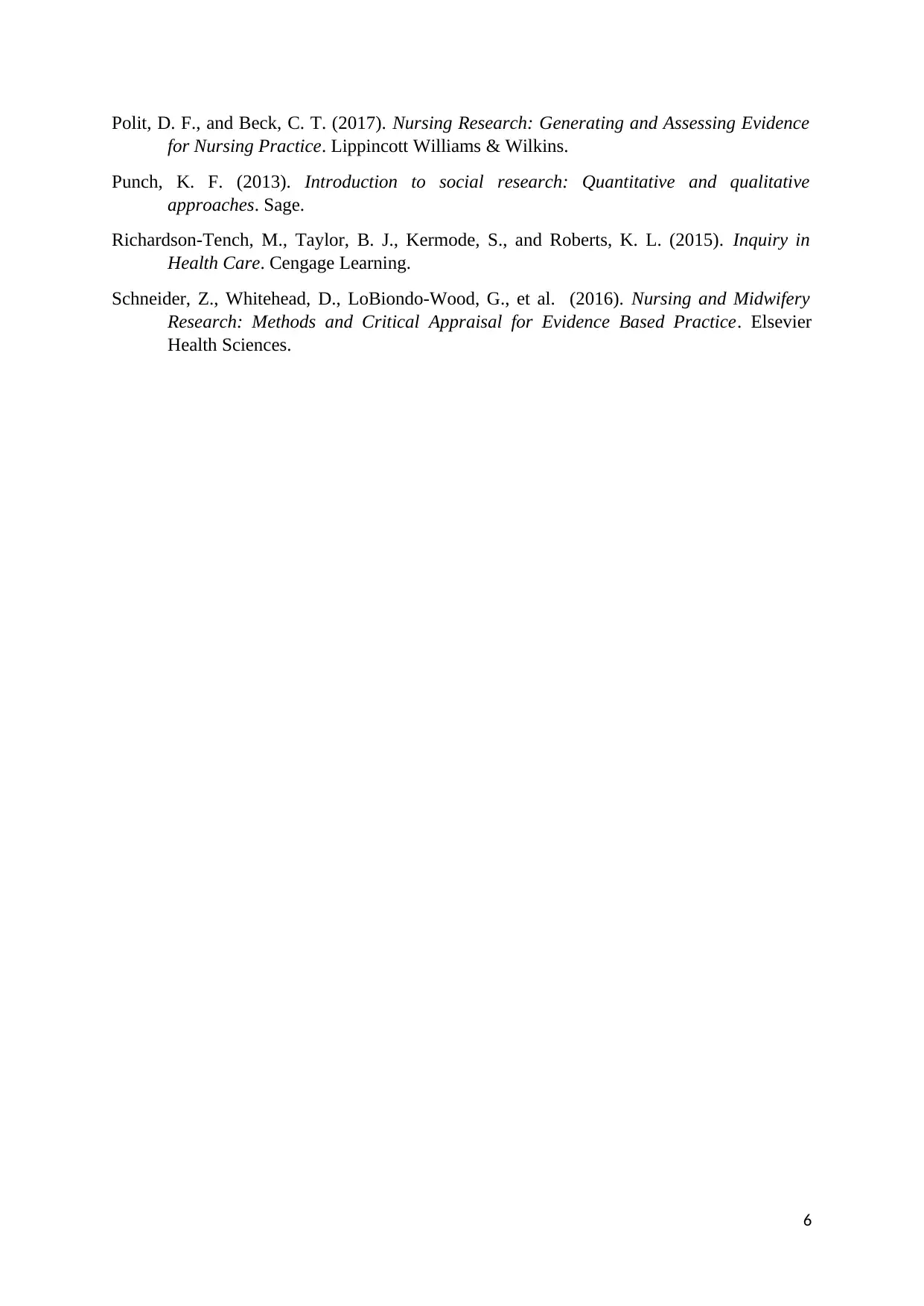
Polit, D. F., and Beck, C. T. (2017). Nursing Research: Generating and Assessing Evidence
for Nursing Practice. Lippincott Williams & Wilkins.
Punch, K. F. (2013). Introduction to social research: Quantitative and qualitative
approaches. Sage.
Richardson-Tench, M., Taylor, B. J., Kermode, S., and Roberts, K. L. (2015). Inquiry in
Health Care. Cengage Learning.
Schneider, Z., Whitehead, D., LoBiondo-Wood, G., et al. (2016). Nursing and Midwifery
Research: Methods and Critical Appraisal for Evidence Based Practice. Elsevier
Health Sciences.
6
for Nursing Practice. Lippincott Williams & Wilkins.
Punch, K. F. (2013). Introduction to social research: Quantitative and qualitative
approaches. Sage.
Richardson-Tench, M., Taylor, B. J., Kermode, S., and Roberts, K. L. (2015). Inquiry in
Health Care. Cengage Learning.
Schneider, Z., Whitehead, D., LoBiondo-Wood, G., et al. (2016). Nursing and Midwifery
Research: Methods and Critical Appraisal for Evidence Based Practice. Elsevier
Health Sciences.
6
⊘ This is a preview!⊘
Do you want full access?
Subscribe today to unlock all pages.

Trusted by 1+ million students worldwide
1 out of 6
Related Documents
Your All-in-One AI-Powered Toolkit for Academic Success.
+13062052269
info@desklib.com
Available 24*7 on WhatsApp / Email
![[object Object]](/_next/static/media/star-bottom.7253800d.svg)
Unlock your academic potential
Copyright © 2020–2025 A2Z Services. All Rights Reserved. Developed and managed by ZUCOL.



